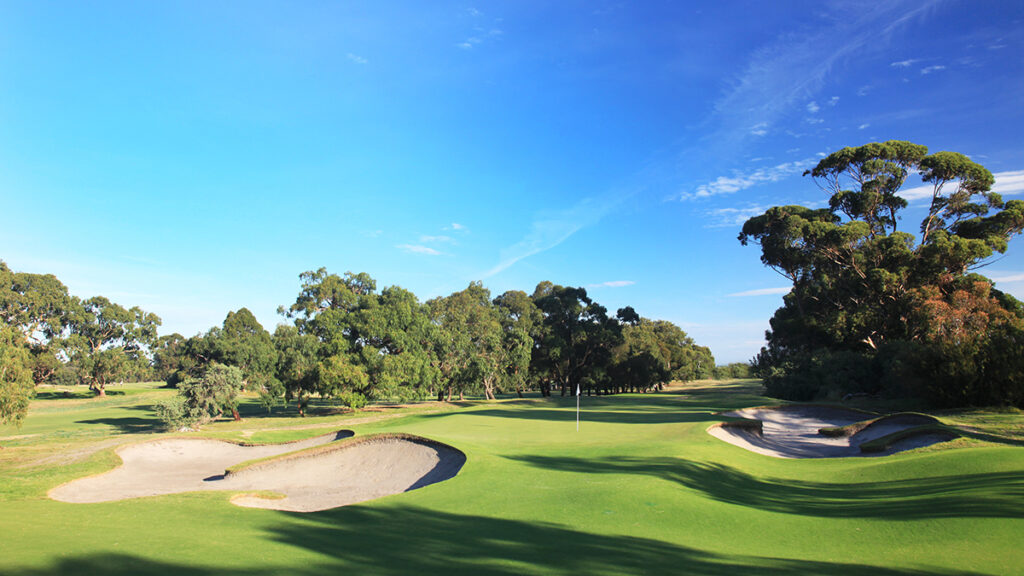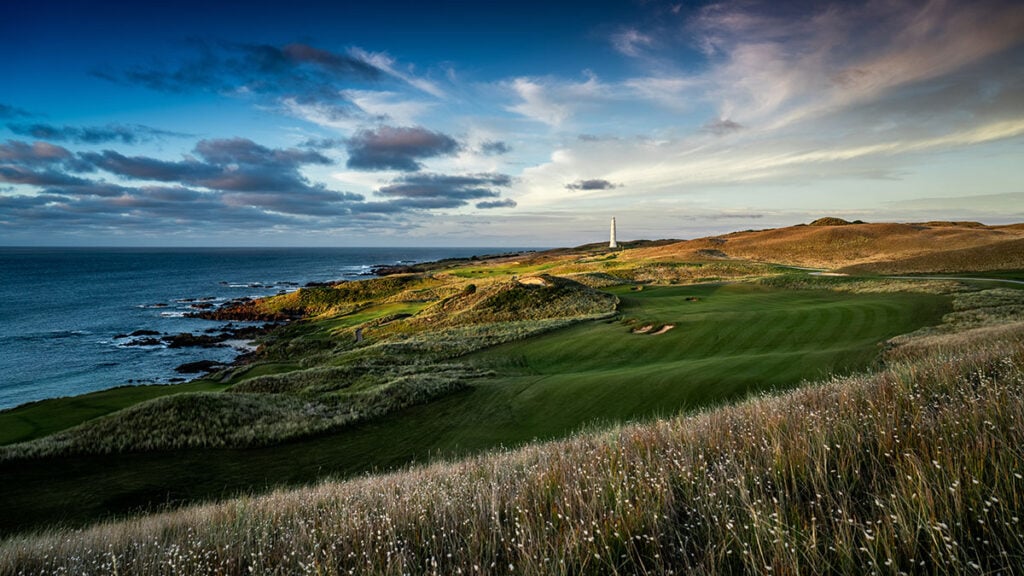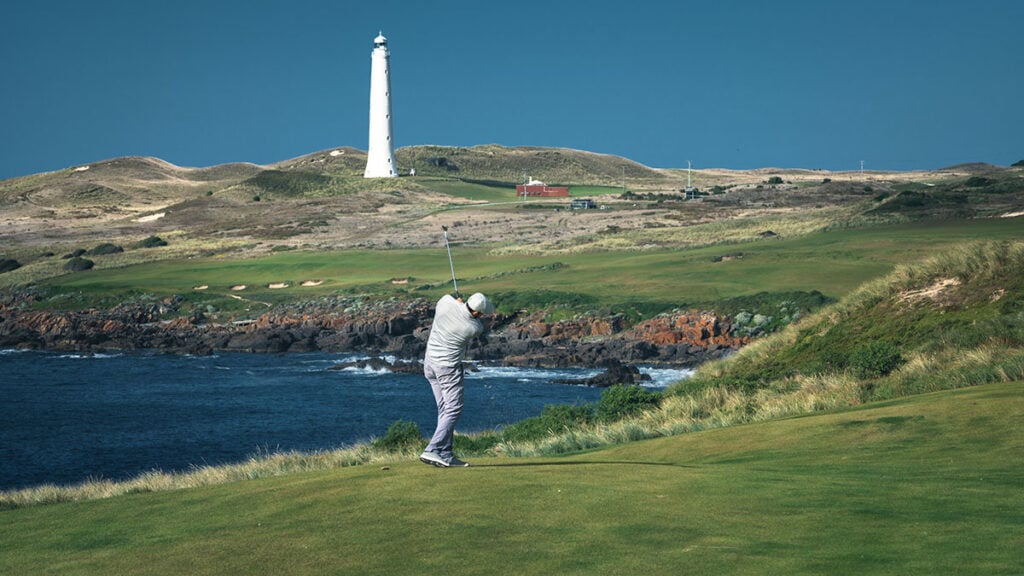A selection of stops to include on a golf-led caravan tour of Australia
So you’ve decided to get on board the caravan caper and take your clubs aboard an extra set of wheels as you traverse the country. First up, good for you. We’re insanely jealous of what lies ahead of you. Secondly, you have a problem – but a what a wonderful problem to need to solve: where do you go?
Depending on your inclination, available time and financial resources, this excursion might last any duration from a few weeks to the rest of your life. And that last point is no exaggeration – some caravanners pack up, sell their homes and most of their possessions and never go back! As a concept, that’s equal parts thrilling and scary.
Given the chance, most travelling golfers will want to touch as many parts of the country as they can, top to bottom and left to right. Here are eight options in four states, with two more caravan-friendly courses in the accompanying story [see page 100]. Don’t forget, too, that the Spirit of Tasmania vessels cater for caravans, should you want to cross Bass Strait and include our island state in your adventures.
Mt Isa, QLD
The culmination point of this year’s Outback Queensland Masters, Mt Isa Golf Club is a friendly club in a region full of unfriendly landscapes. That’s the stuff off the fairway, though. On the cut stuff, you’ll find a course than surprises many visitors with its quality and strategy.
The course is the only one in north-western Queensland with grass greens and the 18-hole layout uses its barren environment to full effect. “Our rocks are our bunkers,” laughs secretary-manager Margie McDonald of the sand-less course. The past few years have seen a focus on improving the layout’s irrigation. All tees, greens and almost all the fairways are now grassed, which is a vast improvement from when the fairways were almost dirt and rock. “We’ve now got very distinctive fairways and a little bit of a rough and then the ‘rough’ rough,” McDonald says of the desert terrain. “It’s quite a challenging course, actually. We get a lot of players who come from down south that play off fairly low handicaps and it’s quite challenging for them. People love the course. They’re quite surprised we’ve got such a well-kept course – grass on it out in the Outback. A lot of people come here expecting it to be a lot more dirt.”
Ocean Shores, NSW
Ocean Shores Country Club has recovered well from severe floods that impacted the New South Wales Northern Rivers region last year. The Ocean Shores community in north Byron Shire was decimated by the floods with low-lying areas of town inundated with water. Insurance payouts have allowed the club to invest $500,000 in new machinery. The club has also engaged course architect Richard Chamberlain to prepare a course masterplan focusing on bunker quantity and positioning. The plan is to make Ocean Shores more playable and not as penal for less-accomplished golfers without compromising the challenge for better players.
Established as Australia’s first residential golf estate in 1972, Ocean Shores is about a 30-minute drive from both Coolangatta and Ballina airports. Blessed with a subtropical climate, Ocean Shores is known for its chilled environment – much like what Byron Bay used to be three decades ago. Ocean Shores and neighbouring Brunswick Heads have seven kilometres of ocean frontage. Surfing and water sports are popular as well as trekking in the Byron hinterland. And for cyclists, a 24-kilometre stretch of the Northern Rivers Rail Trail from Murwillumbah opened in March. The track will extend 132 kilometres to Casino when finished.
Calderwood Valley, NSW
Twenty minutes south of Wollongong, and within minutes of Albion Park, sits the tranquil and hidden Calderwood Valley course. Calderwood’s Australiana influence is evident in the gum trees, meandering creeks and an exciting series of valley-like holes that snake through woodlands – like the par-5 12th hole. A downhill tee shot sets up an exciting and challenging approach to a green carved into the side of a hill.
Set on 30 hectares of green farmland, the par-70 layout, which was designed by McKay & Sons, utilises its rugged Illawarra Escarpment surrounds as a backdrop. It also might be the most welcoming course on the NSW South Coast, and that’s saying something considering the ‘southern hospitality’ within a few hundred kilometres of coastal golf. Calderwood prides itself on being the “South Coast’s friendliest golf facility”, given anyone can walk in, while the green fees are affordable. Playing 18 holes will cost you just $30 most weekdays (“Terrific Tuesdays” cost just $24) and $36 on the weekend, while there’s also a twilight rate after 2pm, seven days. Social groups and players are the focus (there are no competitions), with 30 carts available and advance bookings open as far into the future as 2030.
Bermagui, NSW
Bermagui Country Club is where Hall of Famer Laura Davies prevailed in a playoff to win an ALPG event in 2001. Bermagui is a typical under-rated country track with wide fairways and small greens. Apart from the opening and closing holes (one, nine, 10, 18), which sit upon low-lying tidal flats, the Bermagui layout is undulating for the remaining 14 holes. Several drives and approach shots need to negotiate sloping land or steep elevation changes, heightening the importance of assured ball-striking.
The terrain is in keeping with the rolling countryside of Central Tilba, the location for TV series “River Cottage Australia” that championed organic food and local produce. Fresh seafood can be enjoyed across the road at Bermagui Fisherman’s Wharf where local trawlers are major suppliers to the Sydney Fish Market.
Black Bull, VIC
The Murray River is a haven for caravanners and no course along the majestic watercourse ranks higher than Black Bull Golf Club. The total facility includes a burgeoning residential precinct and Sebel resort as well as the golf course, but even those golfers towing their own accommodation have something to stop for.
Black Bull is rated the 73rd-best course in the country in Australian Golf Digest’s most recent Top 100 Courses ranking. The layout is heavily bunkered, the fairways are generous and so are the greens. Holes meander between a series of small lakes before reaching a crescendo at the treacherous par-5 18th where the green hugs Lake Mulwala. Earlier, golfers walk or drive through a ranch-style entrance at the fourth that marks the start of a demanding three-hole stretch in the south-eastern corner of the course dubbed the ‘Bull Ring’. The par-3 fourth stretches to 180 metres and calls for a forced carry over water while the par-4 sixth plays longer than 400 metres from the back tees and into a prevailing westerly wind, making it the most difficult hole on the course.
Like most modern courses, there’s a variety of teeing grounds to cater to players of all standards and golfers are told they can tee off wherever they like, though only golfers who are brave or foolish (or both) tend to tackle Black Bull from the imposing black tees.

Woodlands, VIC
Suburban Melbourne might not immediately strike you as prime caravanning country, yet the outskirts of our largest cities in particular are home to more caravan parks than you might realise. Plus, it’s Melbourne – and which golfer doesn’t want to take on that city’s best courses?
Something of an enigma in Melbourne golf circles, Woodlands Golf Club either is or isn’t part of the famed stretch of land comprising the city’s Sandbelt courses, depending on whom you ask. What isn’t a source of debate, however, is just how impressive the 22nd-ranked golf course in Australia is. A premium on placement is the hallmark of the early holes before the layout becomes slightly more expansive.
Short, tight and quirky in places, Woodlands is best summarised by the 251-metre fourth hole, which plays as a par 4 towards an open green but one that’s perched like a tabletop. The steep run-offs on each side form the defence, so while the hole invites a drive onto or near the green, any pitch shot needs to be played from the perfect angle to avoid embarrassment.
With outstanding and abundant bunkering, Woodlands looks, sounds and feels like a course befitting the Sandbelt moniker, regardless of your geographical definition of where it begins and ends.
Southern, VIC
Another ‘sleeper’ course on the fringe of Melbourne’s Sandbelt well worth visiting is Southern Golf Club. “We are proud of our club and our course and the culture within the club is as strong as I have ever seen it,” says general manager Brad Robb. “People come to Southern and love it here, our course is always presented well and we have a great relaxed environment.”
Activity levels are high within the club, with course architects OCM starting redesign work on the layout later this year. The firm provided the club with a masterplan a few years ago and it is now embarking on the first major changes from that plan. “The two nines are very different and we want to address that and reset, get back to what this region is famous for and that is quality Sandbelt golf courses,” Robb says. “There is plenty happening at Southern Golf Club. It feels like it has come post-COVID and is a different place now. We paid off our clubhouse debt last year and that was a major milestone for the club. We have a healthy balance sheet and can continue to invest money back into the course and clubhouse. We have great plans in place, some improvements are coming to the practice facilities, and we are currently setting up what we believe will be one of the best junior golf academies in the country.”
Busselton, WA
In the west, Busselton Golf Club is still brimming with pride after snaring two major awards at the WA Golf Industry Awards. Busselton received the Regional Golf Course of the Year and Regional Golf Facility of the Year for 2022 on the strength of successful renovation work and increases in membership.
Judges noted that: “Busselton continues to be one of the best-presented and must-play courses in the south-west. The course is maintained in prime condition and their course superintendent works very closely with the various government agencies to ensure the Busselton Golf Club is at the forefront of environmental strategies and implementation.”
Lance Knox, Australian Golf Digest’s reigning Superintendent of the Year, is a large part of the reason for the accolades. During the past two years at Busselton, Knox’s team has completed numerous improvement projects. They constructed a new bentgrass nursery, upgraded the existing maintenance facility, reconstructed green complexes and redesigned greenside bunkers.
The course is a central part of the Margaret River golf scene. Fairways wend through corridors of redgum and peppermint trees to reach some of the best greens in this corner of the country. The par-72 layout is known for its challenging hazards, which demand strategic shot placement. It’s also home to a range of wildlife, including kangaroos, which add to Busselton’s charm.



